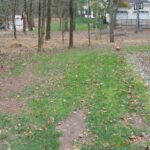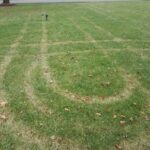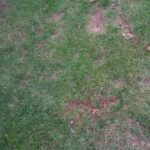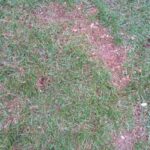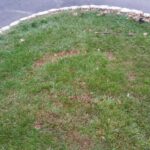Table of Contents
ToggleLast Updated on May 2, 2025
I have walked countless properties with homeowners during service visits to their lawns, and one of the questions I’m asked frequently is, “If your company is taking care of my lawn, where are these bare spots coming from?” The question is often posed after we have strolled past several seemingly random bald patches of lawn here and there. “Is this disease? Do I have grubs? Is it because the technician is dripping chemicals from his spray gun?” While these lawn issues in question have the potential to cause damage to the grass, none of them cause the grass to disappear suddenly.
So how have small areas of the lawn disappeared? The answer is often far simpler than you would think. The good news is that there’s no additional treatments needed to combat this particular lawn pest. The bad news is that the monster gobbling up portions of your lawn may in fact be you!
It’s Common Sense
When you see a bed of flowers or shrubs, is your first impulse to drive over them? Of course not! You could potentially damage them. Yet, one of the most basic practices employed by every homeowner since the dawn of suburbia involves driving a mower (or at the very least pushing a heavy, wheeled implement) on top of the thousands of plants that comprise our lawns. However, we expect these plants to hold up without consequence to the regular mower traffic, when the machines weigh several hundred pounds.
Don’t worry I’m not suggesting that you shouldn’t mow the lawn, or that you should expect the quality of the lawn to suffer a great deal after every cut. What I am telling you though is not to expect the relatively fragile living ecosystem that is your lawn to hold up to mower traffic indefinitely.
Wear and Tear
The damage typically caused by mower traffic is two-fold; there is the wear caused by the frequent traffic over the same areas over and over, and the tear caused by the mower wheels physically tugging at the plants.
Have you ever noticed the depressions that develop in the road where car tires ride over it day after day? This same depression effect occurs as a result of mower traffic in the lawn, and soil compaction issues develop. In central New Jersey we have clay soil, and while it doesn’t mean you can simply pick up a handful of it and start sculpting, it does mean that when it is wet it’s softer and more easily compacted. Once it dries, as you would expect clay to, it hardens in its compacted state. This process repeated over and over causes the already microscopic pore spaces between the soil particles to become non-existent. Once the pore spaces are gone the soil becomes impenetrable to water and oxygen, which is a bad thing for the grass plants. The longer this process goes unchecked, the more compacted the soil becomes, and the more the lawn suffers. Like the road, the lawn becomes worn out very gradually, so immediate damage is not evident for years.
The effects of long-term mower stress can be seen in the lower portion of this image where the lawn has been worn away in two parallel spots by the continuous mower traffic through the same path.
You can, however, sometimes see short term effects from compaction. If plants are already suffering under extremely hot or cold weather conditions, you can see streaks develop along mower tracks in the lawn due to the additional compression stress. While the lawn generally recovers from this, it helps to highlight the fact that there are consequences to mower traffic.
The image above shows temporary stress from machine traffic that occurred following frost.
The second type of mower stress is the tear caused by traction of the tires. As the mower makes turns, the tires pull on the plants and can sever their stems or uproot them altogether. If the lawn is mowed following heavy irrigation or rainfall, the soil is easily torn up by the tire traction and can cause ruts. This type of stress is certainly more evident, and something that most homeowners try to keep from happening. However, this too can be very subtle. Minor ruts in the lawn that happen every now and again can add up over time. It isn’t until several small injuries accumulate that the homeowner takes notice.
The images above show damage to the lawn that has been caused by mower tear. However, the diagnosis is hard to make given the vantage from which it is being viewed and the time that has lapsed since the most recent cut.
So, What’s the Solution?
To avoid damage that may develop from compaction caused by mower traffic, it is imperative that the lawn be core aerated on a regular basis. For most residential lawns, core aerating every-other-year should be often enough to keep the soil compaction from becoming an issue. Also, if there are areas that stay wet due to poor drainage, they should be addressed professionally by a landscaper to resolve this problem. Areas such as these become damaged exponentially faster than well-drained areas and core aeration will most likely not provide ample correction on its own.
Also, avoid mowing the lawn when it is saturated or following a heavy storm. Homeowners with in-ground irrigation should also consider their watering schedule and set irrigation to run as far from the mowing schedule as possible. For example, if the lawn is typically mowed on Mondays, irrigation should be run on Tuesday or Wednesday so that the maximum amount of time lapse occurs between heavy watering and mower traffic.
Though it may sound obvious, seed the damaged areas. It is a great practice to go through the lawn at the end of each summer and spot seed the lawn as necessary. This keeps small damaged spots from being able to accumulate over time.
Finally, try to avoid creating narrow sections of turf in your landscape designs. Mowers are forced to traffic the lawn in the same pattern regularly through these bottle-neck areas, causing the grass to wear away quickly. If you must have narrow passages between landscape beds, these should have some other alternate ground cover in place such as gravel, stone paths, or low-lying shrubs. Long-term turf growth should only be expected to occur with reasonable maintenance in well drained areas of the property that are fully exposed to the sun.
Conclusion
There is wear and tear that occurs as a result of nearly every regular practice developed by human beings. Just like brushing your teeth or jogging each morning, with mowing the benefit outweighs the consequences that may come as a result. Your lawn care specialist may point out to you that mowing the lawn has contributed to some turf loss in your lawn. Luckily, there are some simple best practices that can help reduce mowing stress to the turf.
If you are in our service area and have questions about possible mowing damage or mowing best practices, please give our office a call at 908-281-7888, or request an estimate.

